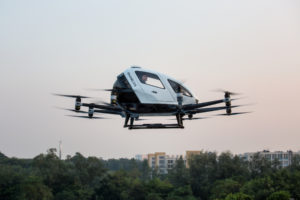
Urban air mobility (UAM) could provide a major benefit for the disabled community. A new white paper from Aerobility and CIVATAglobal says the industry must be inclusive from the outset to realize that goal as passenger drones are introduced.
While the concept of integrating air taxis, drone taxis, passenger drones, or flying cars into community transportation systems may have seemed impossible even a few years ago, the concept is rapidly becoming a reality. China is leading the way, already using passenger drones for emergency response and tourism and planning to implement the technology within the next few years. Europe and South Korea are close behind.
Air transportation should provide many benefits to communities. UAM could relieve traffic congestion in urban areas, make regions without a strong road infrastructure more accessible, and help reduce pollution. Air taxis and passenger drones could also provide more transportation options for the disabled community or anyone who may not be able to easily access traditional means of road transportation: autonomous air vehicles may not require navigation by sight, for example. From the white paper:
The new smart city transport systems will reduce the reliance on private cars, improving the quality of life for many and creating healthier and greener cities everywhere. For one important group of people, UAM and AAM [Advanced Air Mobility] offer a particularly important opportunity. Around 10% of the world’s population face major mobility impairment challenges. And with over half of the world’s current 7.8 billion people living in cities, a proportion which grows bigger every year, UAM is not the single biggest opportunity to transform mobility options for millions of people who struggle daily with currently inaccessible ground transport services.
The opportunity to improve the lives of millions cannot be missed – but inclusivity must be built into early models and demonstrations in the same way that wheel chair access is an essential consideration for other transport infrastructure, say the authors. Tools to make urban air mobility accessible for visually impaired people or those requiring wheelchair access will need to be built into the initial industry standards.
Aerobility and CIVITAglobal are… calling for UAM plans to include representatives of disability groups at the earliest possible stage in the process; we want to get best practice in accessibility built into the early development and DNA of the industry, so that those with most to gain are not left behind.

Miriam McNabb is the Editor-in-Chief of DRONELIFE and CEO of JobForDrones, a professional drone services marketplace, and a fascinated observer of the emerging drone industry and the regulatory environment for drones. Miriam has penned over 3,000 articles focused on the commercial drone space and is an international speaker and recognized figure in the industry. Miriam has a degree from the University of Chicago and over 20 years of experience in high tech sales and marketing for new technologies.
For drone industry consulting or writing, Email Miriam.
TWITTER:@spaldingbarker
Subscribe to DroneLife here.







[…] post Passenger Drones Should Benefit the Disabled Community: But Will They? The Need for Inclusivity appeared first on […]